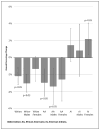Race and Gender Disparities in Lung Cancer Incidence Rates, 2001-2010
- PMID: 26817066
- PMCID: PMC4788019
Race and Gender Disparities in Lung Cancer Incidence Rates, 2001-2010
Abstract
Objective: Despite progress to reduce the burden of tobacco, disparities in tobacco-related morbidity and mortality remain. This research examines trends in lung cancer incidence rates by race and by gender within race during 2001-2010 in Oklahoma.
Methods: Incident cases of lung cancer were obtained from the Oklahoma State Department of Health public use database. Cases were linked to the Indian Health Service database to reduce misclassification of American Indian race. Annual percent change (APC) was estimated by race and by gender within race to describe rates over time. Rates were considered to increase or decrease if the p-value for trend was < 0.05.
Results: Average lung cancer incidence rates were highest among American Indians (105.52 per 100,000) and lowest among whites (78.64 per 100,000). Lung cancer incidence rates declined among the overall white (APC: -2.17%; p = 0.001) and African American (APC: -2.95%; p = 0.003) populations, as well as white (APC: -3.02%; p < .001) and African American males (APC: -3.39%; p = 0.007). Rates increased among American Indian females (APC: 2.20%; p = 0.03).
Conclusion: Analysis of lung cancer incidence data reveals an inequality in tobacco-related morbidity among American Indians, especially American Indian females. This research suggests a need for more evidence-based tobacco control interventions within the American Indian population.
Conflict of interest statement
The authors declare that there is no conflict of interests regarding the publication of this paper.
Figures


Similar articles
-
Trends in lung cancer incidence rates, Oklahoma 2005-2010.PLoS One. 2015 Apr 22;10(4):e0119251. doi: 10.1371/journal.pone.0119251. eCollection 2015. PLoS One. 2015. PMID: 25901351 Free PMC article.
-
Racial Misclassification in Mortality Records Among American Indians/Alaska Natives in Oklahoma From 1991 to 2015.J Public Health Manag Pract. 2019 Sep/Oct;25 Suppl 5, Tribal Epidemiology Centers: Advancing Public Health in Indian Country for Over 20 Years(Suppl 5 TRIBAL EPIDEMIOLOGY CENTERS ADVANCING PUBLIC HEALTH IN INDIAN COUNTRY FOR OVER 20 YEARS):S36-S43. doi: 10.1097/PHH.0000000000001019. J Public Health Manag Pract. 2019. PMID: 31348189 Free PMC article.
-
Italian cancer figures, report 2012: Cancer in children and adolescents.Epidemiol Prev. 2013 Jan-Feb;37(1 Suppl 1):1-225. Epidemiol Prev. 2013. PMID: 23585445 English, Italian.
-
[The cutting-edge of medicine; Ethnic and gender differences in lung cancer].Nihon Naika Gakkai Zasshi. 2011 Oct 10;100(10):3064-71. doi: 10.2169/naika.100.3064. Nihon Naika Gakkai Zasshi. 2011. PMID: 22175154 Review. Japanese. No abstract available.
-
Sixth Annual DC Public Health Case Challenge - Reducing Disparities in Cancer and Chronic Disease: Preventing Tobacco Use in African American Adolescents.NAM Perspect. 2022 Feb 7;2022:10.31478/202202b. doi: 10.31478/202202b. eCollection 2022. NAM Perspect. 2022. PMID: 35402856 Free PMC article. Review. No abstract available.
Cited by
-
Epidemiology of lung cancer in northeast of Iran: A 25-year study of 939 patients.Med J Islam Repub Iran. 2020 Mar 7;34:17. doi: 10.34171/mjiri.34.17. eCollection 2020. Med J Islam Repub Iran. 2020. PMID: 32551306 Free PMC article.
-
Misracialization of Indigenous people in population health and mortality studies: a scoping review to establish promising practices.Epidemiol Rev. 2023 Dec 20;45(1):63-81. doi: 10.1093/epirev/mxad001. Epidemiol Rev. 2023. PMID: 37022309 Free PMC article.
-
Recommendations to researchers for aiding in increasing American Indian representation in genetic research and personalized medicine.Per Med. 2021 Jan;18(1):67-74. doi: 10.2217/pme-2020-0130. Epub 2020 Dec 17. Per Med. 2021. PMID: 33332195 Free PMC article.
-
Tobacco Industry Marketing Exposure and Commercial Tobacco Product Use Disparities among American Indians and Alaska Natives.Subst Use Misuse. 2020;55(2):261-270. doi: 10.1080/10826084.2019.1664589. Epub 2019 Sep 23. Subst Use Misuse. 2020. PMID: 31544562 Free PMC article.
-
The relationship between nicotine metabolism and nicotine and carcinogen exposure among American Indian commercial cigarette smokers and electronic nicotine delivery system users.Addict Behav. 2019 May;92:58-63. doi: 10.1016/j.addbeh.2018.10.038. Epub 2018 Oct 28. Addict Behav. 2019. PMID: 30583092 Free PMC article.
References
-
- US Department of Health, Human Services. The health consequences of smoking—50 years of progress: A report of the surgeon general. Atlanta, GA: US Department of Health and Human Services, Centers for Disease Control and Prevention, National Center for Chronic Disease Prevention and Health Promotion, Office on Smoking and Health; 2014. p. 17.
-
- Jemal A, Simard EP, Dorell C, et al. Annual Report to the Nation on the Status of Cancer, 1975–2009, Featuring the Burden and Trends in Human Papillomavirus (HPV)–Associated Cancers and HPV Vaccination Coverage Levels. Journal of the National Cancer Institute. 2013 Feb 6;105(3):175–201. - PMC - PubMed
Publication types
MeSH terms
Grants and funding
LinkOut - more resources
Full Text Sources
Medical
